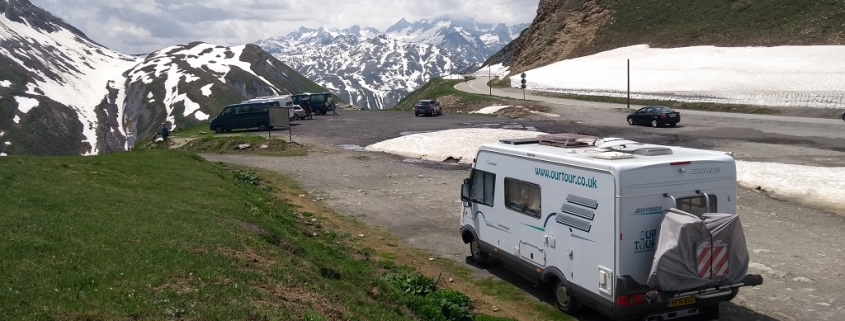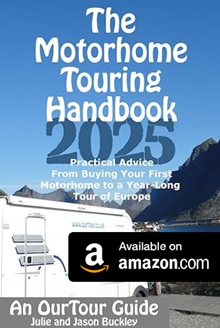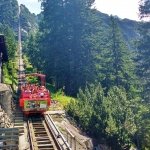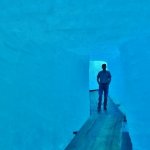Up High on Furka Pass
Zagan the motorhome’s spent a somewhat blustery night at the summit of the Furka Pass, a little over 2400m above sea level, with a view of high mountains camouflaged in grey and white. Even in July it’s cool up here. The temperature dropped to 6°C last night and is hovering around 15°C at the moment (later on it got much warmer as the sun came out), not exactly freezing but it’s 10 or 15 degrees cooler than the valley floor which is now a vertical mile below us. We’ve been lovely and comfy up here, with the gas heating gently chugging away in the morning, hot coffee, hot showers and plenty of blankets. The huge wedges of snow and ice around us seem quite unreal, and everyone arriving is having to touch them.


Our plan is to stay up here another night and head down into the Rhône Valley in the morning, Lidl calls, then the campsite in the Zermatt valley. I’ve always thought of the Rhône as being a French river, which it is of course, but it originates here in Switzerland, a couple of miles from where I’m sat. The river starts life in the Rhône Glacier (the Rhonegletscher), which you can walk to from a car park off the Furka Pass road below us, before being joined by water from the famous Altesch Glacier and flowing off to the west. There’s a tunnel carved into the ice of the Rhonegletscher, and what would be an unassuming bend in the Furka Pass is a tourist mecca with cars and buses parked up when we drove past, trying not to gawp at the small avalanche of snow which had blocked part of the car park. If the weather’s decent in the morning we’ll go have a look before we drive off the pass.

The pass we’re on is the border between two Swiss cantons, Valais and Uri (legendary home of William Tell), and there are a couple of stone markers by the road indicating the divide (it’s also the watershed between the Med and North Sea). If I twist around to my right I can see the silhouette of a bull’s head on a yellow shield, the coat of arms of Uri. Reading up on these cantons leads to a bottomless pit of information about Switzerland, where it’s come from and how it works today. As an example, the CH symbol used by the Swiss stands for ‘Confederation Helvetic’ in English, where the ‘Helvetic’ bit relates back to a pre-Roman tribe who lived in what’s now Switzerland, and the ‘Confederation’ bit refers to how Switzerland was formed and is now governed as a collection of 26 ‘cantons’.

Our latest experience of how these cantons work was the bin bag saga from our last trip here with Phil and Jules. The campsite we stayed on gave each motorhome a specially-marked bin bag which had to be used for non-recyclable rubbish. We’d never seen one like it before, and later discovered they’re pretty expensive as they’re heavily taxed. Although not all cantons had them, being self-governing: there was talk of people storing their rubbish up and driving over the border to another canton to offload the lot and saving a packet. Imagine that in the UK?

Digging just that bit deeper reveals the fact Swiss cantons are a little like Spanish ‘autonomous communities’. They each have their own ability to create local laws, set different income tax rates and so on. The Swiss have the idea of devolving as much power to the inhabitants as possible (using regular referendums to agree or reject new laws). Above that the cantons have the next level of government, and finally powers which really must be given to country-wide government are handled in Bern.
It’s fascinating to see how these cantons work, in comparison to our own form of government back in the UK. Some are historically Protestant and some Catholic, which has caused no-end of trouble in the past like in much of Europe. Some speak a form of German, some French, some Italian, some Romansh, and some a combination of these languages. Most Swiss seem to speak English pretty well too. Some cantons joined the confederation when it was first formed hundreds of years ago (when they were still city states, each with their own army, border controls and currency) and others more recently, gradually building Switzerland over 500 years. Politics is still, unsurprisingly perhaps, somewhat split across language lines, with French-speaking cantons voting in favour of EU entry and German ones against (Switzerland hasn’t joined the EU, but is in the passport-less Schengen Zone and has signed various agreements with the EU over free movement of people etc). They even have a word for this divide: Röstigraben, referring to the grated potato dish rösti traditionally eaten more in German-speaking areas (we love the stuff), although it seems a somewhat tongue-in-cheek expression.

I got chatting with a motorbiker yesterday, after spotting he had a blue L plate on his 700cc motorbike. Back home, you can only ride ‘big’ bikes like this as a learner if you’re accompanied by an instructor, but not here it seems. The chap explained (in perfect English) that anyone over 25 could ride a bike like this for 4 months before needing to demonstrate they were taking instruction, then they got another 12 months before needing to take a test. His comprehensive insurance was about £500 a year. So someone who’s never ridden a motorbike can go out and buy a 150mph missile and head for the mountains that afternoon. Bloody hell fire! He did say the law is being made tighter in a few years, but I was gobsmacked nevertheless.
Anyway, all mountain passes are incredible places to me. The roads were generally built for commerce or military reasons (or the odd one seemingly to satisfy the ego of a tyrant), some back in Roman times and others much more recently. A few stay open all year, some using a tunnel at some point to bypass the top in winter. Others close from about October or November when the snow starts to fall, re-opening as late as June. Looking around us it’s clear this pass gets buried under building-high snow, with huge telegraph-poles being snapped like twigs by the road, and metal railings twisted by simply unstoppable force. A car train runs for 15km under the Furka Pass, allowing you to nip under the mountain and bypass this winter wonderland/frozen hell in 20 minutes 365 days a year, sat in your car (or up to 3.5 tonne motorhome) atop a train carriage.

There are trails leading off from the car park here and I nipped out along one of them for a leg-loosener ahead of this weekend’s big run (see video below), only getting a mile before having to turn back and use the road instead. I’d already gingerly crossed a steep snow field, but bottled it at a much larger one with a very long drop-off into the valley. As I turned back I passed hikers heading the other way. The Swiss know what they’re doing I think, and I suspect they’d ice axes on ’em to self-arrest if they did trip or slip. I left my ice axes at home. :-)

We’re up to over an incredible £1000 for the British Lung Foundation now!!! Thanks you so much! If you want to read more or contribute something (anything), please go to our secure Just Giving page. Many thanks, Jay
When it’s clear of snow the pass is easy to drive even in a heavy motorhome. Full-sized buses are regularly passing the top, and the hairpins are wide, some supported on concrete stilts lifting the road high in the air and providing a ton of turning area. That doesn’t stop me getting a bit edgy though, as these places are just so alien to me, so much height in the sky with Widescreen HD Drawn-On vistas furrowing my brow and leaving my mouth hanging open in awe. I’ve often wondered how much an environment affects the people born and raised in it. How much does living so close to such magnificent (and potentially dangerous) nature instill a sense of humility, adventure and pride in the Swiss, I wonder?

Anyway, enough rambling on! Ju’s knocking up a cheese omelette and I’m watching a group of British 20-somethings about to drive off down the pass ahead of me. The police have just pootled onto the parking area and off again, and there’s the usual steady stream of bikers pulling in for a photo and maybe a cigarette before pulling their helmet on again and growling off along the road. The other three motorhomes which stayed last night have left, and I suspect most people find these passes a ‘1 nighter’ as unless you’re out hiking (or blogging) there’s not much to do once you’ve stared at the view. The weather was supposed to be bad by now, with thunderstorms forecast, but it’s actually just clouded over and heating up, maybe we’ll get the rain and lightening later on. We’ve picked a spot alongside a small hill for some cover from the wind, some distance from the edge of the car park, and have chocked the wheels for some peace of mind.
[edit] A bit of laughter from the kitchen as I was finishing typing this: it seemed I’d bought hard boiled eggs in Lidl! They were coloured slightly and on offer, but were in with the other eggs and I’d no clue they weren’t fresh. No omelette for us today! [end of edit]
Right, that’s it, better go before lunch is served! Cheers, Jay





Leave a Reply
Want to join the discussion?Feel free to contribute!